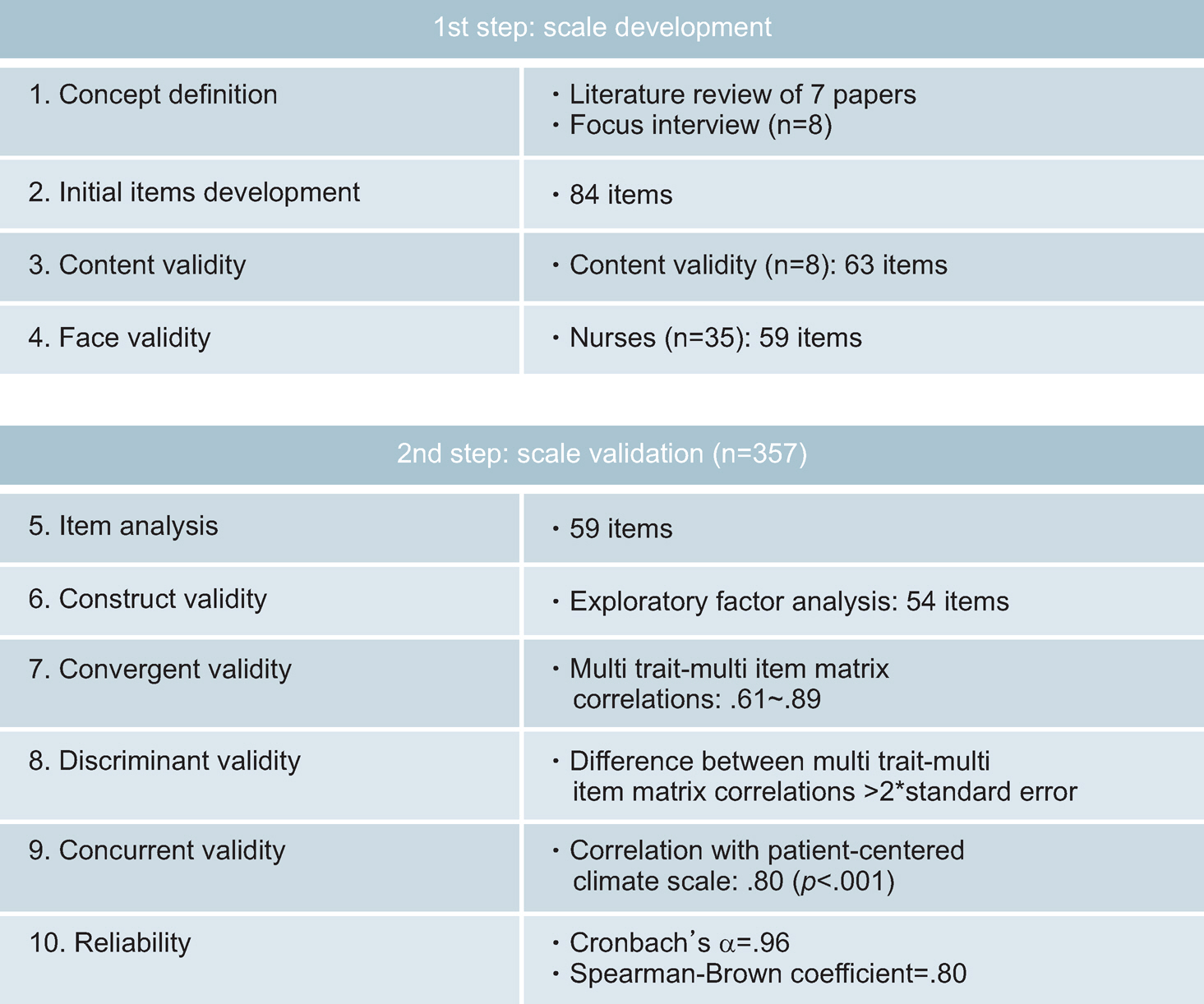J Korean Acad Nurs.
2019 Oct;49(5):613-630. 10.4040/jkan.2019.49.5.613.
Development of the Patient-Centered Nursing Culture Scale for Hospitals
- Affiliations
-
- 1Department of Nursing, Inje University, Busan, Korea. nurysh@inje.ac.kr
- 2Institute for Health Science Research, Inje University, Busan, Korea.
- KMID: 2461860
- DOI: http://doi.org/10.4040/jkan.2019.49.5.613
Abstract
- PURPOSE
This study aimed to develop a scale measuring the Patient-Centered Nursing Culture (PCNC) and provide a basic tool to improve PCNC in Korea.
METHODS
A conceptual framework and construct factors were extracted through extensive literature review and in-depth interviews with nursing professionals. In total, 59 items were derived based on the pilot survey. Data were collected from 357 nurses working at general hospitals and analyzed for verifying the reliability and validity of the scale.
RESULTS
Nine factors containing 54 items were extracted from the exploratory factor analysis to verify the construct validity. The nine factors were top management leadership, policy and procedure, education and training, middle management leadership, supportive teamwork, nursing workplace environment, professional competence, patient-centered nursing activity, and nurses' values. These items were verified by convergent, discriminant, and concurrent validity testing. The internal consistency reliability was acceptable (Cronbach's α=.96).
CONCLUSION
The developed PCNC scale is expected to be used as the tool for the development of theory and improvement of PCNC, the empirical testing for cause and effect of PCNC, the development of interventions, education and training programs for improving PCNC, and indicators for evaluation or accreditation of hospital service quality.
MeSH Terms
Figure
Reference
-
References
1. Institute of Medicine Committee on Quality of Health Care in America. Crossing the quality chasm: A new health system for the 21st century. Washington, D.C.: National Academy Press;2001. p. 1–8.2. Do YK, Kim JE, Lee JY, Lee HY, Cho MW, Kim EN, et al. Research Affairs of SNU & SNU R&DB Foundation. Development of patient centeredness evaluation model. Seoul: Health Insurance Review & Assessment;Service; 2015 May. Report No.: G000E70-2015-87.3. Dabney BW, Tzeng HM. Service quality and patient-centered care. Medsurg Nursing. 2013; 22(6):359–364.4. Small DC, Small RM. Patients first! Engaging the hearts and minds of nurses with a patient-centered practice model. The Online Journal of Issues in Nursing. 2011; 16(2):2.
Article5. Otani K, Waterman B, Faulkner KM, Boslaugh S, Dunagan WC. How patient reactions to hospital care attributes affect the evaluation of overall quality of care, willingness to recommend, and willingness to return. Journal of Healthcare Management. 2010; 55(1):25–37. discussion38.
Article6. Ben Natan M, Hochman O. Patient-centered care in healthcare and its implementation in nursing. International Journal of Caring Sciences. 2017; 10(1):596.7. Kvåle K, Bondevik M. What is important for patient centred care? A qualitative study about the perceptions of patients with cancer. Scandinavian Journal of Caring Sciences. 2008; 22(4):582–589. https://doi.org/10.1111/j.1471-6712.2007.00579.x.
Article8. Schein EH. Organizational culture and leadership: A dynamic view. San Franciso (CA): Jossey-Bass;1985. p. 1–358.9. DeVellis RF. Scale development: Theory and applications. 3rd ed. Thousand Oaks (CA): Sage;2012. p. 73–115.10. Hobbs JL. A dimensional analysis of patient-centered care. Nursing Research. 2009; 58(1):52–62. https://doi.org/10.1097/NNR.0b013e31818c3e79.
Article11. Gerteis M, Edgman-Levitan S, Daley J, Delbanco TL. Through the patient’s eyes: Understanding and promoting patient-centered care. San Francisco (CA): Jossey-Bass;1993. p. 1–360.12. Rathert C. Patient-centered care, work climates, and patient safety: An exploratory study [dissertation]. Lincoln (NE): University of Nebraska–Lincoln;2005. p. 1–149.13. Shaller D. Patient-centered care: What does it take? [Internet]. New York: The Commonwealth Fund;c2007. [cited 2018 Feb 17]. Available from:. https://www.commonwealthfund.org/pub-lications/fund-reports/2007/oct/patient-centered-care-what-does-it-take.14. Hunt D. QSEN competencies: A bridge to practice. Nursing Made Incredibly Easy! 2012; 10(5):1–3. https://doi.org/10.1097/01.NME.0000418040.92006.70.15. McCormack B, McCance TV. Development of a framework for person‐centred nursing. Journal of Advanced Nursing. 2006; 56(5):472–479. https://doi.org/10.1111/j.1365-2648.2006.04042.x.
Article16. Takase M, Teraoka S. Development of the holistic nursing competence scale. Nursing & Health Sciences. 2011; 13(4):396–403. https://doi.org/10.1111/j.1442-2018.2011.00631.x.
Article17. Krippendorff K. Content analysis: An introduction to its methodology. 2nd ed. Thousand Oaks (CA): Sage;2004. p. 1–413.18. Lynn MR. Determination and quantification of content validity. Nursing Research. 1986; 35(6):382–385.
Article19. Choi CK, Kim JG. A study on the effect of leadership, organizational culture and the fitness on the organizational effectiveness -cases from Korean big 4 conglomerates-. Journal of Organization and Management. 2010; 34(4):139–167.20. Pfeiffer Y, Manser T. Development of the German version of the hospital survey on patient safety culture: Dimensionality and psychometric properties. Safety Science. 2010; 48(10):1452–1462. https://doi.org/10.1016/j.ssci.2010.07.002.
Article21. Lee SG. Development and psychometric evaluation of the Korean patient safety culture survey instrument for hospitals [dissertation]. Seoul: Chung-Ang University;2015. p. 1–142.22. Kim HG. A study on the causal relationships among organizational culture, leadership, and organizational commitment. Korean Society and Public Administration. 2007; 18(2):23–49.23. Lee JY. Effective communication for patient safety. Journal of the Korean Medical Association. 2015; 58(2):100–104. https://doi.org/10.5124/jkma.2015.58.2.100.
Article24. Aiken LH, Patrician PA. Measuring organizational traits of hospitals: The revised nursing work index. Nursing Research. 2000; 49(3):146–153. https://doi.org/10.1097/00006199-200005000-00006.
Article25. Lake ET. Development of the practice environment scale of the nursing work index. Research in Nursing & Health. 2002; 25(3):176–188. https://doi.org/10.1002/nur.10032.
Article26. McCormack B, McCance T, Slater P, McCormick J, McArdle C, Dewing J. Person‐centred outcomes and cultural change. Manley K, McCormack B, Wilson V, editors. International Practice Development in Nursing and Healthcare. Oxford: Blackwell Publishing;2008. p. 189–214.
Article
- Full Text Links
- Actions
-
Cited
- CITED
-
- Close
- Share
- Similar articles
-
- The influence of professional competency, professional commitment, and nursing organizational culture on the person-centered practice of nurses in long-term care hospitals: A cross-sectional study
- Factors Related to Intensive Care Unit Nurses' Patient Centered Communication Competency
- Development and Validation of a Person-Centered Perioperative Nursing Scale
- The Influence of Ethical Nursing Competence and Positive Nursing Organizational Culture on Person-Centered Care in Intensive Care Unit Nurses: A Cross-Sectional Survey
- Factors Influencing the Performance of Person-centered Care Among Nurses in Designated COVID-19 Hospitals


